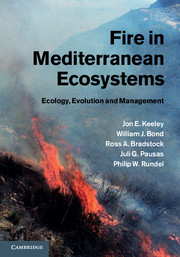7 - Fire in the Cape Region of South Africa
from Section II - Regional patterns
Published online by Cambridge University Press: 05 January 2012
Summary
South Africa's mediterranean-type climate (MTC) region is the smallest of the five MTC regions, centered in the southwestern corner of the Western Cape Province (Fig. 7.1). This Cape region is dominated by fynbos shrublands (see Fig. 1.6e) but this fynbos biome continues eastward far outside the MTC. The Cape region is unusual in that shrublands dominate under climate regimes that also support forests. Entire landscapes can support alternative ecosystem states. Even the semi-arid areas can support entirely different vegetation: fire-prone shrublands or fire-resistant broadleaf thickets. Perhaps more than any other MTC region, fire plays a central role in determining major vegetation patterns of winter rainfall regions of South Africa. Soils are also thought to be of major importance since much of the Cape's MTC region is on nutrient-poor sandy soils (see Fig. 1.5). A complex interplay between soils, fire and climate and, in the east, large mammal herbivory, determines boundaries of major biomes. The Cape Floristic Region is extremely rich in species with very high levels of endemism (Linder 2003). It is the world's richest temperate flora and is largely restricted to fire-prone ecosystems (Cowling et al. 1996; Linder 2003). So, contrary to the widely held popular belief that fires are an anthropogenic disturbance (e.g. Pillans 1924; Axelrod 1980), or merely incidental to this formation (Hopper 2009), a rich endemic flora has evolved in the Cape whose members are overwhelmingly fire dependent, implying a long history of natural fires as a selective force.
Major Vegetation Patterns
This chapter discusses fire regimes in the Cape region, what little is known of their determinants, and how they influence major vegetation patterns in the region. Though a large number of studies have explored plant responses to fire (reviewed by Bond 1997; Cowling et al. 1997a), these are heavily biased toward fynbos shrublands, the dominant vegetation cover of the region (Fig. 7.2). Fire responses of species belonging to other vegetation types are poorly known. Yet the existence of these other vegetation types is one of the central conundrums of the Cape region. It implies failure of climate alone to explain apparent convergence with other MTC regions (Chapter 1). For example, low shrublands would be expected in deserts replaced, as rainfall progressively increases, by taller shrublands, woodlands and then forests. But this is clearly not the case in the Cape region. The dominant fynbos vegetation shows very little variation in aboveground biomass from arid desert fringes (mean annual precipitation ~250 mm) to rain-drenched high-altitude heathlands (> 3000 mm) (Fig. 7.3). Yet across the entire rainfall gradient fynbos co-occurs with alternative ecosystems with much greater woody biomass. These broadleaf thickets and forests have an entirely different floristic and functional composition and often are restricted to isolated fire-protected refugia (Fig. 7.2; Taylor 1978; Kruger 1979; Cowling et al. 2005; Rebelo et al. 2006). The implication is that apparent convergence of shrubby fynbos growth forms with other MTC plant communities cannot be understood in terms of climate alone and that one needs to think in terms of the climate, fire, geology filter (see Fig. 1.4).
- Type
- Chapter
- Information
- Fire in Mediterranean EcosystemsEcology, Evolution and Management, pp. 168 - 200Publisher: Cambridge University PressPrint publication year: 2011



